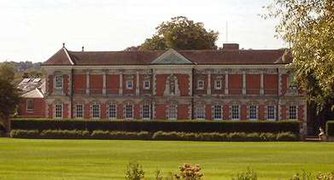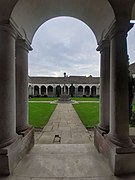Architecture of Winchester College

The architecture of Winchester College is a diverse set of architectural styles, reflecting the multiple periods of building from the college's foundation in 1382, through additions in the medieval and Early Modern periods, to a major expansion of accommodation in the Victorian era and then further extensions at the turn of the 20th century and more recently. The styles involved include those of Christopher Wren, Brunelleschi, Queen Anne revival, and High Victorian Baronial. Among the architects whose work is represented in the ensemble are William Butterfield, G. S. Repton, G. E. Street, William White, Basil Champneys, E. S. Prior, Herbert Baker, and Henry Hill.
Winchester College has numerous listed buildings from these periods, including the 1924 War Cloister.
Architecture by period
Winchester College, founded in 1382, consists physically of an assemblage of buildings from medieval times to the present day.[1] Several are listed buildings;[a][3] There are 18 Grade I, 6 Grade II* and over 70 Grade II listings for its buildings,[4] including many of the houses on both sides of Kingsgate Street, and some further south on Kingsgate Road.[2]
The medieval foundation
The medieval buildings, representing most of the original foundation from the school's opening in 1394, include Outer Gate and Outer Court, Chamber Court, the Chapel, and the Cloisters. Most are built in flint with limestone facings and slate roofs.[5][4] The Cloisters have Italianate wagon roofs and bare external walls; the inside walls have gothic arched openings, each divided into three lights.[6]
The south side of Chamber Court is formed by the chapel of St. Mary, known simply as "Chapel". It retains its original wooden fan-vaulted ceiling, designed by Hugh Herland, carpenter to Richard II.[7] The college's dining hall, known as "Hall", is housed in the same range of buildings in ashlar stonework, on the first floor to the west of Chapel. Hall has wooden panelling, installed in 1540.[6][8] The four-stage tower, visible from all around the college, was demolished and rebuilt in 1862–1863.[6]
The chapel is known for its stained glass. The East window depicts the Tree of Jesse. Down the chapel's north and south sides is a collection of saints. Little of the original medieval glass, designed by Thomas Glazier, survives. A firm of glaziers in Shrewsbury, Betton and Evans, was tasked with cleaning the glass in the 1820s. At that time there was no known process for cleaning the badly deteriorated glass and so it was copied, while most of the original glass was scattered or destroyed. Some pieces have been recovered. The art historian and Old Wykehamist, Kenneth Clark, bought back the Tree of Jesse section of the east window, now housed in Thurburn's Chantry, at the back of the chapel. Further figures have been returned; they form the east window of Fromond's Chantry, inside the Cloisters.[7]
Chapel's east window with Victorian stained glass
Medieval to Early Modern
Later buildings include Fromond's Chantry, built inside the Cloisters after 1420,[6] and "School", constructed in 1683–1687 in Wren style,[4] with a 1692 statue of the college's founder William of Wykeham above the door by C. G. Cibber.[6] The College Sick House, known as Bethesda, was built by the school's warden John Harris in 1656–1657.[9] It is constructed mainly of brick with mullioned windows; the front has two large gables, flanking a smaller central gable that projects forward, housing the door.[6]
The Warden's Lodgings is constructed largely of red brick; the face North on to College Street has its lower part in flint with stone buttresses, the upper part with lightly-arched windows dated to 1730, while the East face. on to the Warden's gardens and the River Itchen, dates to Warden Nicholas's reworking of the building in 1692.[6]
Lierne vault in Fromond's Chantry, 15th century
The building called "School" in Wren style, 1683–1687
Victorian
The school was greatly extended in the 19th century with the addition of boarding houses for "commoners", paying pupils, as opposed to the scholars who continued to live in the medieval College. The first two were Chernocke House and Moberly's, which began as private houses owned by teachers. The third, Du Boulay's, was built speculatively by the Reverend James Du Boulay, borrowing money against the hope of future paying boarders. In 1869, six more boarding houses were added, four of them built speculatively under the headmaster George Ridding. The original and surviving sports field was the walled area of Meads, just behind School; other fields were added in the 19th century on both sides of the River Itchen.[10] The "forbidding" neo-Gothic Headmaster's House (no longer used for that purpose), its front in knapped and squared flint, was built by G. S. Repton in 1839–1842.[6]
Just to the south of the Headmaster's House are Flint Court and Moberly Court, designed by William Butterfield (the architect of Keble College, Oxford) and built between 1867 and 1870. Flint Court is open at the front; the wings to left and right are of 3 storeys, in red brick, described by Pevsner as "partly chequer, partly diaper"; the centre has a single-storey Perpendicular-style cloister in front of the full-height range.[6]
In the 1880s, a large Sanatorium, designed by William White, was built in High Victorian Baronial style in 1884–1893; it has been described as "an all too prominent feature"[11] of the school's landscape.[6] It is now used as the college's art school.[4]
For the school's 500th anniversary, the handsome but impractical Brunelleschi-style building called "Museum" (formally named "Memorial Buildings") by Basil Champneys, intended to support all the arts and sciences, was opened in 1897.[12] Nikolaus Pevsner described it as "curiously Baroque", in brick and Bath stone, arranged in nine bays with columns; the windows are flanked by prominent stone blocks projecting from and alternating with brickwork. The first and last bays are solid, with statues of William of Wykeham and of Queen Victoria. The building has a loggia with two rows of Tuscan-style columns, forming part of the ground floor.[6]
Headmaster's House by G. S. Repton, 1839–1842
Sergeant's House by G. E. Street, one of the 1869 boarding houses[13]
The old Sanatorium building in High Victorian Baronial by William White, 1884–1893
Inside the loggia of the 1897 "Museum" by Basil Champneys, with a cast of Donatello's Cantoria for Florence Cathedral
River Itchen, playing fields (Science School in the background)
Modern
The flint and greenstone Music School, designed by E. S. Prior, was added in 1903–1904. The building is octagonal, with large round-topped gables fronting a pyramidal roof. It was extended in the 21st century with a mixture of yellow brick, limestone dressings, glass, and zinc cladding.[6]
The Science School was designed by Henry L. G. Hill in what the college calls Queen Anne revival style, and completed in 1904; it remains in use for its original purpose.[4] The building is in red brick, dressed with white Portland stone. Pevsner describes the style as "richly decorated ... Wrenaissance".[14] The hipped roofs are covered with slate, above a cornice with modillion eaves. An extension was designed by T. D. Atkinson around 1930.[14]
To the west of Meads, the college's War Cloister serves as a memorial to the Wykehamist dead of the two World Wars. It was designed by Herbert Baker and dedicated in 1924. It is a listed building.[15] A bronze bust of Old Boy Air Chief Marshal Lord Dowding sits on the west side of the cloister.[15] The College's South Africa Gate on Kingsgate Street commemorates the Wykehamist dead of the 1899–1902 Boer War. It leads to the War Cloister.[16] Another older war memorial in the school is the entry chamber to Chapel, known as "Crimea" after the Crimean War of 1853–56, and bearing the names of Wykehamists who died at the siege of Sebastopol.[17]
A hall big enough for the enlarged school, New Hall, was opened in 1961, just east of the Mill Leat, a branch of the River Itchen. Its design was constrained by the need to accommodate the magnificent oak panelling which had been taken out of Chapel in that building's "disastrous"[18] internal redesign of 1874. The interior of New Hall with Warden Nicholas's 1680–1683 panelling has been called "a triumph".[18]
The development of a "Southern Campus" comprising a PE centre, swimming pool, rifle range, and squash courts by the architects Design Engine began in 2017 on the site between the Kingsgate Park sports field and the Norman Road tennis courts. The "complex geometry of the roof forms" is intended to reference the silhouette of the college's historic buildings, while the sports centre's grey brick and the other buildings' red brick is meant to reflect the tones of the medieval flint and brick. The "substantial" buildings are designed to be "largely hidden" from outside the college.[19]
Music School by E. S. Prior, 1903–1904
War Cloister by Herbert Baker, 1924
Notes
References
- ^ Page, William, ed. (1912). "Winchester: St Mary's College". A History of the County of Hampshire. British History Online. Vol. 5. London: Victoria County History. pp. 14–19. Retrieved 3 November 2022.
- ^ a b "St Mary's College Chapel, College Street
- ^ Listed buildings include: Chapel: 1350684; College Hall: 1095484; Chamber Court: 1296879; Warden's Lodgings: 1167489; Outer Court: 1095483; Cloisters: 1296887; Fromond's Chantry: 1095485; School: 1167544; College Mill: 1296819; Mill House, The Wharf: 1388258; Moberly Court and Flint Court: 1095490; Headmaster's House: 1296847; Sergeants: 1389672; Du Boulays: 1389673; Garden boundary wall to South of Du Boulays: 1389674; Chernocke House: 1389671; War Cloister: 1095486; South Africa Gateway and adjoining buildings: 1296843; Memorial Buildings [Museum]: 1167595; Sick House [Bethesda]: 1350685; Church of St Michael: 1350710; Science School: 1389670; Music School: 1296290; New Hall: 1296802;
- ^ a b c d e "Buildings and Grounds". Winchester College. Retrieved 27 October 2022.
- ^ Sabben-Clare 1981, pp. 1–3.
- ^ a b c d e f g h i j k l "Winchester College, Hampshire: Late 14th century". Astoft. Retrieved 28 October 2022. (3 pages) partly consisting of text from Pevsner, Nikolaus; Lloyd, David (1967). Hampshire and the Isle of Wight. Yale University Press., with 84 photographs of the buildings
- ^ a b "Chapel". Winchester College. Retrieved 4 October 2020.
- ^ Banerjee, Jacqueline (19 December 2009). "Winchester College and its Architecture: An Introduction". The Victorian Web. Retrieved 3 November 2022.
- ^ Sabben-Clare 1981, p. 5.
- ^ Sabben-Clare 1981, pp. 13–17.
- ^ Sabben-Clare 1981, p. 24.
- ^ Sabben-Clare 1981, pp. 20–21.
- ^ "House from Home: Sergeant's (Phil's)". Winchester College. 9 March 2021. Archived from the original on 19 April 2021. Retrieved 28 October 2022.
- ^ a b "Science School at Winchester College". Historic England. Retrieved 3 November 2022.
- ^ a b "The War Cloister, Winchester College". Historic England. Retrieved 4 October 2020.
- ^ "Wykehamists- Boer War". Imperial War Museum. Retrieved 7 October 2020.
- ^ "Winchester College Crimea". Imperial War Museum. Retrieved 7 October 2020.
- ^ a b Sabben-Clare 1981, pp. 24–26.
- ^ "Southern Campus". Design Engine Architects. Archived from the original on 23 May 2022. Retrieved 3 November 2022.
Sources
- Sabben-Clare, James (1981). Winchester College. Paul Cave Publications. ISBN 978-0-86146-023-6.


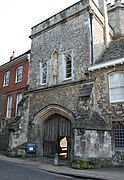
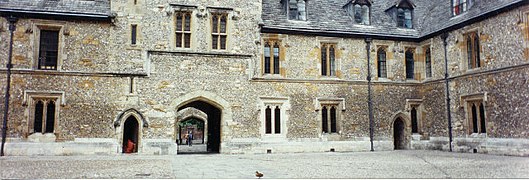




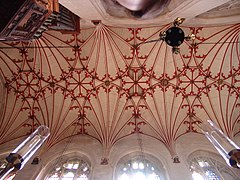







![Sergeant's House by G. E. Street, one of the 1869 boarding houses[13]](https://upload.wikimedia.org/wikipedia/commons/thumb/e/e5/Sergeant%27s_House_on_Romans_Road.jpg/199px-Sergeant%27s_House_on_Romans_Road.jpg)



